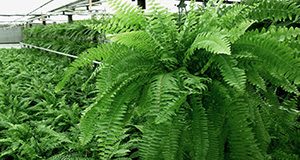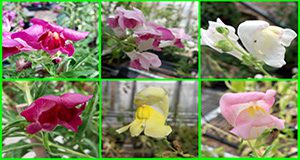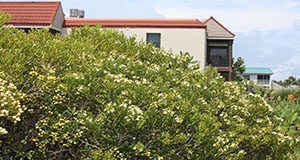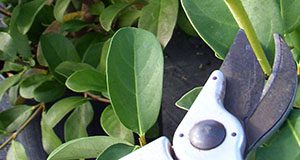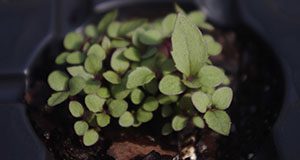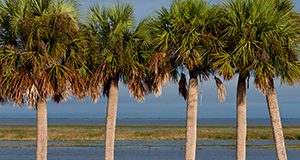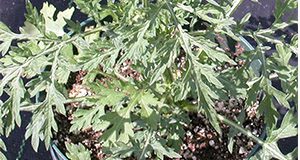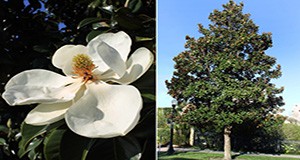La grama o césped St. Augustine está muy adaptada a las zonas calurosas y húmedas (subtropicales) del mundo. Se cree que es nativa de las regiones costeras del Golfo de México y del Mediterráneo. St. Augustine es la especie de grama más usada en Florida. This is the Spanish-language version of ENH5/LH010, St. Augustinegrass for Florida Lawns. St. Augustinegrass is the most commonly-used lawn grass in Florida. This 10-page document describes its cultivation and management for Florida lawns. Written by L. E. Trenholm, J. B. Unruh, T. W. Shaddox, C. Balerdi, and H. Mayer and published by the UF/IFAS Department of Environmental Horticulture, January 2018.
http://edis.ifas.ufl.edu/ep552
Tag: Department of Environmental Horticulture
Cultural Guidelines for Commercial Production of Boston Fern (Nephrolepsis exaltata ‘Bostoniensis’)
‘Bostoniensis’, or Boston fern, is a popular sword fern variety that is one of the most important foliage crops in the ornamental plant industry. This 5-page article describes common Boston fern cultivars, provides guidelines for their culture and interior use, and lists physiological problems that may be encountered during production and interiorscape use. Written by Bill Schall, Heqiang Huo, and Jianjun Chen and published by the UF/IFAS Department of Environmental Horticulture, January 2018.
http://edis.ifas.ufl.edu/ep550
The Fate of Nitrogen Applied to Florida Turfgrass
The quality of Florida’s surface and ground waters is of utmost importance to the flora and fauna living in them, as their growth is directly related to the amount of nutrients in these waters. In order to make informed decisions regarding nitrogen (N) applications to turfgrass, it is important to understand the N cycle in the soil/turfgrass system. The objective of this 8-page publication is to identify and describe the sources and potential fates of N applied to Florida turfgrass. Written by T.W. Shaddox and J.B. Unruh and published by the UF/IFAS Department of Environmental Horticulture, January 2018.
http://edis.ifas.ufl.edu/ep546
Planting and Propagation of Snapdragons in Florida
Snapdragons are a common plant in Florida landscapes and are one of the top ten fresh-cut flowers in the nation. This 5-page publication, written by Heqiang Huo and Jianjun Chen, explores the planting and propagation of snapdragons in Florida landscapes. Published by the UF/IFAS Department of Environmental Horticulture, January 2018.
http://edis.ifas.ufl.edu/ep549
Iron for Florida Turfgrasses
Iron (Fe) is commonly applied to enhance turfgrass color. Understanding the dynamics of Fe both in the plant and in the soil could greatly enhance your nutrient management programs. The objective of this 4-page publication is to explain the function of Fe within the plant, describe the Fe sources available for turfgrasses, and identify which forms of Fe are most effective in improving turfgrass quality. Written by Travis Shaddox and J.B. Unruh and published by the UF/IFAS Department of Environmental Horticulture, January 2018.
http://edis.ifas.ufl.edu/ep551
Joewood (Jacquinia keyensis): Identification and Uses
Jacquinia keyensis, known commonly as joewood, is listed as a threatened species by the state of Florida, and is most commonly found in the Florida Keys. This 8-page document discusses the identification and uses of joewood. Written by Stephen H. Brown, Marc S. Frank, and Andrew K. Koeser and published by the UF/IFAS Department of Environmental Horticulture, January 2018.
http://edis.ifas.ufl.edu/ep548
How to Calibrate Your Fertilizer Spreader
Fertilizer application is only effective if you ensure uniform coverage. This 5-page document discusses the calibration and use of fertilizer spreaders for successful application. Written by T.W. Shaddox, J.B. Unruh, and L.E. Trenholm and published by the UF/IFAS Environmental Horticulture Department, November 2017.
http://edis.ifas.ufl.edu/lh024
Biology and Management of Liverwort (Marchantia polymorpha) in Ornamental Crop Production
Liverwort is a common weed problem in production nurseries and greenhouses. This article has been written to help growers identify liverwort, understand its biology, and inform them of ways this weed can be managed in their operation. Written by Chris Marble, Marc S. Frank, Dail Laughinghouse, Shawn Steed, and Nathan Boyd, and published by UF’s Environmental Horticulture Department, September 2017.
http://edis.ifas.ufl.edu/ep542
Helpful Details for Commercial Propagation of Woody Plant Stem Cuttings
This three-page fact sheet provides details that are very important for successful propagation of woody plant stem cuttings, such as sanitation, quality of cuttings, the time of year/day to take cuttings, stem size diameter and length of cutting, location of cuts/terminal bud removal, and environmental conditions. Written by Thomas Yeager and published by the Environmental Horticulture Department.
http://edis.ifas.ufl.edu/ep536
Biology and Management of Thickhead (Crassocephalum crepidioides) in Ornamental Crop Production
Typically found in shadehouses and shaded areas of nursery production, thickhead grows aggressively in containers and can outcompete nursery crops for water, nutrients, and light. This erect, sparingly branched, herbaceous annual, grows up to 4 feet tall and germinates over a wide range of pH, salt, and temperature conditions. This four-page fact sheet describes thickhead (Crassocephalum crepidioides) and various methods for its control in ornamental crop production. Written by Allison Bechtloff, Shawn Steed, Chris Marble, and Nathan Boyd and published by the Environmental Horticulture Department.
http://edis.ifas.ufl.edu/ep534
Fertilization of Field-Grown and Landscape Palms in Florida
Palms growing in Florida landscape or field nurseries are subject to a number of potentially serious nutrient deficiencies. This five-page document discusses the prevention and treatment of these deficiencies. Written by Timothy K. Broschat and published by the Environmental Horticulture Department.
http://edis.ifas.ufl.edu/ep261
Biology and Management of Ragweed Parthenium (Parthenium hysterophorous L.) in Ornamental Crop Production
This six-page fact sheet provides an overview of Ragweed Parthenium, Parthenium hysterophorous L, including a species description and information on how to manage ragweed parthenium culturally, physically, and chemically. Written by Debalina Saha, Chris Marble, Robert H. Stamps, and Shawn Steed and published by the Environmental Horticulture Department.
http://edis.ifas.ufl.edu/ep531
How to Use a Dichotomous Key: A Tutorial Featuring 10 Common Shade Trees of the Tampa Bay Area
A dichotomous key is a tool used to help identify an unknown organism. This twelve-page fact sheet features a key of leaf characteristics for ten common broadleaf trees in the Tampa Bay Area. Accurately navigating this series of paired, either-or choices about leaf characteristics will lead the reader to identify the correct tree from the group of ten. Written by Andrew K. Koeser, Gitta Hasing, Michael G. Andreu, and Melissa H. Friedman and published by the Environmental Horticulture Department.
http://edis.ifas.ufl.edu/ep510
10 Common Palms of the Tampa Bay Area
Palms often serve as key specimens in urban landscape designs. Despite this, their identity is often unknown to Florida’s new, seasonal, and even long-term residents. This ten-page fact sheet serves as a quick reference for some of the most common palms found in North and Central Florida and the Tampa Bay Area in particular. Written by Gitta Hasing, Andrew K. Koeser, Melissa H. Friedman, and Timothy K. Broschat and published by the Environmental Horticulture Department.
http://edis.ifas.ufl.edu/ep506
Chilling Injury in Tropical Foliage Plants: III. Dieffenbachia
A chilling temperature is any temperature that is cold enough to cause plant injury but not cold enough to freeze the plant. Chilling injury can occur to tropical foliage plants if greenhouses become too cold or if plants are exposed to chilling temperatures outside of the greenhouse during packing and shipping. Dieffenbachia, commonly known as dumb cane, ranks among the top five most popular foliage plant genera produced and sold in the United States. This four-page fact sheet describes the chilling temperatures of Dieffenbachia cultivars in order to assist growers to better manage greenhouse temperatures. Written by Jianjun Chen and published by the Environmental Horticulture Department.
http://edis.ifas.ufl.edu/ep530
Ten Common Flowering Trees of the Tampa Bay Area
Blooming trees serve as key focal points in the urban landscape. Florida’s flowering trees can be quite spectacular and leave you wondering, Wow, what tree is that?
This 7-page guide written by Gitta Hasing, Andrew K. Koeser, Gary W. Knox, and Melissa H. Friedman and published by the Environmental Horticulture Department will assist you in identifying the 10 most common flowering trees that grow in the Tampa Bay area of Florida. It is an efficient resource for master gardeners, novice tree inventory crews, 4-H forestry teams, and others interested in basic flowering tree identification.
edis.ifas.ufl.edu/ep505
Landscape Design Software: Evaluation and Recommendations for Homeowners

Homeowners who are computer literate and want to improve their landscapes often consider purchasing software so that they can create the design themselves and save money. To help you select a program from the dozens that are available, each with different levels of cost and difficulty, UF/IFAS scientists tested seven popular do-it-yourself programs, compared them to a professional landscape design software program, and rated them for quality of features and ease-of-use. This 9-page fact sheet written by Gail Hansen, Smith Watkins, and Sydney Park Brown and published by the Department of Environmental Horticulture will help you estimate costs, ensure compatibility with your Windows-based or Apple-based operating system, and compare reviews from consumer websites so that you can choose the software that best fits your needs.
edis.ifas.ufl.edu/ep526

